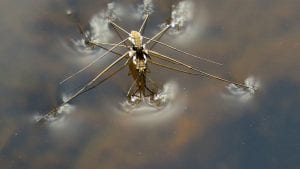
Aquatic insects such as the pictured water bug use the same nanoscale surface roughness as the experimental, synthetic compounds in order to remain dry. (Source: Wikimedia Commons)
Oftentimes, the state of being “underwater” and being “wet” are used synonymously, but one can be wet without being underwater; and according to researchers at Northwestern University, one can be underwater without being wet (1).
Through a combination of analysis of “air-retaining insect surfaces” used by aquatic insects, aging and degassing experiments on material surfaces, and molecular simulations, these engineers believe they understand what keeps certain surfaces dry underwater: saturation of air within “valleys” on surfaces (less than 1µm wide) that deflects water, resulting in water droplets resting on the surface instead (1,2).
Whereas materials with this key surface roughness remained dry when submerged in ambient fluids, materials without this roughness did not. The materials with the nanoscale roughness remained dry for long periods of time in conditions that varied liquid pressure and degassing. The water-solid interfaces were imaged using scanning electron microscopy. The degassing experiments also demonstrated that the air within the pores was due to vapor pressure of the ambient fluid rather than liquid condensation (1).
In addition, Paul Jones and the team determined that insects use the nanoscale spacing hairs on their leg to create this same type of surface roughness (1,2).
However, in most cases, this air dissolves from the pores back into the ambient liquid and the surface becomes capable of becoming wet. The Northwestern researchers determined that the width of the pores can be optimized to retain the saturated air, which would keep the surface dry (1).
The researchers calculated the ideal conditions for a material to remain dry based on the pore diameter, pressure of gas within the pore, liquid pressure, liquid-gas surface energy, and the equilibrium contact angle the liquid would have on a flat surface of that material. They believe that this nanoscale roughness is the key to retaining the vapor phase equilibrium that allows for the saturation of air within the pores of these surfaces (1).
These findings may have significant implications for many industries that work with aerodynamics and fluid drag, and may possibly be used to reduce the energy expenditure or increase efficiency in these industries (1,2).
References
- Paul R. Jones, Xiuqing Hao, Eduardo R. Cruz-Chu, Konrad Rykaczewski, Krishanu Nandy, Thomas M. Schutzius, Kripa K. Varanasi, Constantine M. Megaridis, Jens H. Walther, Petros Koumoutsakos, Horacio D. Espinosa, Neelesh A. Patankar. Sustaining dry surfaces under water. Scientific Reports, 2015; 5: 12311 DOI: 1038/srep12311
- Northwestern University. (2015, August 18). Engineers identify how to keep surfaces dry underwater for months: Research team is first to identify surface ‘roughness’ required to achieve amazing feat. ScienceDaily. Retrieved August 20, 2015 from www.sciencedaily.com/releases/2015/08/150818142601.htm